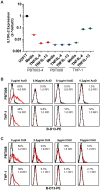Cytokine induction of VCAM-1 but not IL13Rα2 on glioma cells: a tale of two antibodies
- PMID: 24787244
- PMCID: PMC4008428
- DOI: 10.1371/journal.pone.0095123
Cytokine induction of VCAM-1 but not IL13Rα2 on glioma cells: a tale of two antibodies
Abstract
The interleukin-13 receptor alpha2 (IL13Rα2) is a cell surface receptor that is over-expressed by a subset of high-grade gliomas, but not expressed at significant levels by normal brain tissue. For both malignant and non-malignant cells, IL13Rα2 surface expression is reported to be induced by various cytokines such as IL-4 or IL-13 and tumor necrosis factor (TNF). Our group has developed a therapeutic platform to target IL13Rα2-positive brain tumors by engineering human cytotoxic T lymphocytes (CTLs) to express the IL13-zetakine chimeric antigen receptor. We therefore sought to investigate the potential of cytokine stimulation to induce IL13Rα2 cell surface expression, and thereby increase susceptibility to IL13Rα2-specific T cell killing. In the course of these experiments, we unexpectedly found that the commercially available putative IL13Rα2-specific monoclonal antibody B-D13 recognizes cytokine-induced VCAM-1 on glioblastoma. We provide evidence that the induced receptor is not IL13Rα2, because its expression does not consistently correlate with IL13Rα2 mRNA levels, it does not bind IL-13, and it is not recognized by IL13-zetakine CTL. Instead we demonstrate by immunoprecipitation experiments and mass spectrometry that the antigen recognized by the B-D13 antibody following cytokine stimulation is VCAM-1, and that VCAM-1, but not IL13Rα2, is induced on glioma cells by TNF alone or in combination with IL-13 or IL-4. Further evaluation of several commercial B-D13 antibodies revealed that B-D13 is bi-specific, recognizing both IL13Rα2 and VCAM-1. This binding is non-overlapping based on soluble receptor competition experiments, and mass spectrometry identifies two distinct heavy and light chain species, providing evidence that the B-D13 reagent is di-clonal. PE-conjugation of the B-D13 antibody appears to disrupt IL13Rα2 recognition, while maintaining VCAM-1 specificity. While this work calls into question previous studies that have used the B-D13 antibody to assess IL13Rα2 expression, it also suggests that TNF may have significant effects on glioma biology by up-regulating VCAM-1.
Conflict of interest statement
Figures







References
-
- Han SJ, Zygourakis C, Lim M, Parsa AT (2012) Immunotherapy for glioma: promises and challenges. Neurosurg Clin N Am 23: 357–370. - PubMed
-
- Ruzevick J, Jackson C, Phallen J, Lim M (2012) Clinical trials with immunotherapy for high-grade glioma. Neurosurg Clin N Am 23: 459–470. - PubMed
-
- Debinski W, Gibo DM, Slagle B, Powers SK, Gillespie GY (1999) Receptor for interleukin 13 is abundantly and specifically over-expressed in patients with glioblastoma multiforme. Int J Oncol 15: 481–486. - PubMed
-
- Jarboe JS, Johnson KR, Choi Y, Lonser RR, Park JK (2007) Expression of interleukin-13 receptor alpha2 in glioblastoma multiforme: implications for targeted therapies. Cancer Res 67: 7983–7986. - PubMed
Publication types
MeSH terms
Substances
Grants and funding
LinkOut - more resources
Full Text Sources
Other Literature Sources
Miscellaneous

